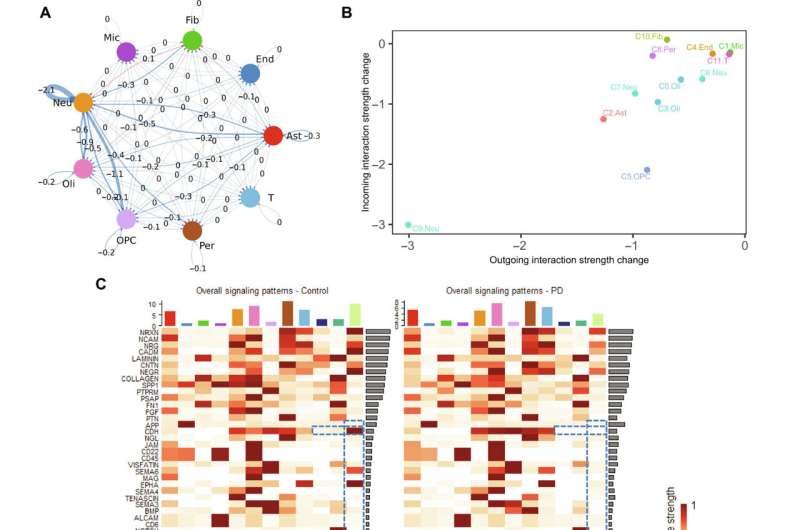This article has been reviewed according to Science X's editorial process and policies. Editors have highlighted the following attributes while ensuring the content's credibility:
fact-checked
peer-reviewed publication
trusted source
proofread
Researchers identify diverse neuron types associated with vulnerability to Parkinson's disease

Through transcriptomic profiling of more than 300,000 cells in human substantia nigra, a part of the brain that helps control the body's movements, a research team has identified a previously unreported neuron type with vulnerability in Parkinson's disease. This novel finding could help explain the complexity of the disease symptoms and direct new therapeutics development.
The paper is published in the journal Science Advances.
Parkinson's disease pathology is characterized by the loss of dopaminergic (DA) neurons in the substantia nigra. Whether cell types beyond DA neurons in this brain region show vulnerability in Parkinson's disease remains unclear.
Through transcriptomic profiling of 315,867 high-quality single nuclei in the substantia nigra from individuals with and without Parkinson's, the researchers identified cell clusters representing various neuron types, glia, endothelial cells, pericytes, fibroblasts, and T-cells, and investigated cell-type dependent alterations in gene expression in Parkinson's disease.
Notably, a unique neuron cluster marked by the expression of RIT2, a Parkinson's risk gene, also displayed vulnerability in Parkinson's disease. The researchers validated this human finding of RIT2-enriched neurons in both midbrain organoids and the substantia nigra of mice.
The results demonstrate distinct transcriptomic signatures of the RIT2-enriched neurons in the human substantia nigra and implicate reduced RIT2 expression in the pathogenesis of Parkinson's disease. Overall, the study sheds light on the diversity of cell types, including DA neurons, in the substantia nigra and the complexity of molecular and cellular changes associated with Parkinson's disease pathogenesis.
The study has established a transcriptomic atlas of the human substantia nigra at single-cell resolution and delineated the landscape of molecular and cellular alterations in Parkinson's disease.
This study not only provides a valuable resource for dissecting molecular and cellular compositions and structures of the human substantia nigra, but also presents an unprecedented opportunity to understand in-depth pathogenic mechanisms, identify key therapeutic targets, and develop clinical biomarkers for Parkinson's disease.
The study investigated postmortem brain tissue from Parkinson's disease patients, human stem cell-derived organoids, and animal models. The average age of the postmortem brains was 81 years.
The team performed transcriptomic profiling of more than 300,000 cells in the human substantia nigra and found the diversity and vulnerability of neurons in Parkinson's disease brains.
Researchers isolated nuclei from the postmortem brain and ran snRNAseq analysis. They also performed RNAscope and immunofluorescence staining to validate the snRNAseq results.
Overall, the study sheds light on the diversity of cell types, including DA neurons, in the substantia nigra and the complexity of molecular and cellular changes associated with PD pathogenesis.
Said Mount Sinai's Dr. Zhenyu Yue of the research, "Our study shows the landscape of transcriptomic signatures with cell type resolution in a brain region that is vulnerable in Parkinson's disease. We are surprised by the finding of a neuron type with vulnerability in PD, which has never been characterized previously."
"In addition, our study provides the opportunity to interrogate the remaining dopamine neurons at advanced disease stages and identify clues for how they are adapted and survive while the vast majority of dopamine neurons are lost."
Said Mount Sinai's Dr. Bin Zhang of the research, "Equally significant is the identification of molecular alterations in different brain cell types in PD. These findings provide not only profound insights into the underlying pathogenic mechanisms but also vital therapeutic targets for PD."
Said James C. Beck, Ph.D., Chief Scientific Officer of the Parkinson's Foundation, "This work helps solve a fundamental issue in tackling brain diseases by unraveling the unique diversity and nature of cells within the brain. By creating this atlas provides guideposts for others to follow in the study of Parkinson's. Moreover, the work of Drs. Yue, Zhang, and colleagues epitomize the goal of the Parkinson's Foundation Research Centers—a team coming together to help solve Parkinson's disease."
More information: Qian Wang et al, Molecular profiling of human substantia nigra identifies diverse neuron types associated with vulnerability in Parkinson's disease, Science Advances (2024). DOI: 10.1126/sciadv.adi8287




















